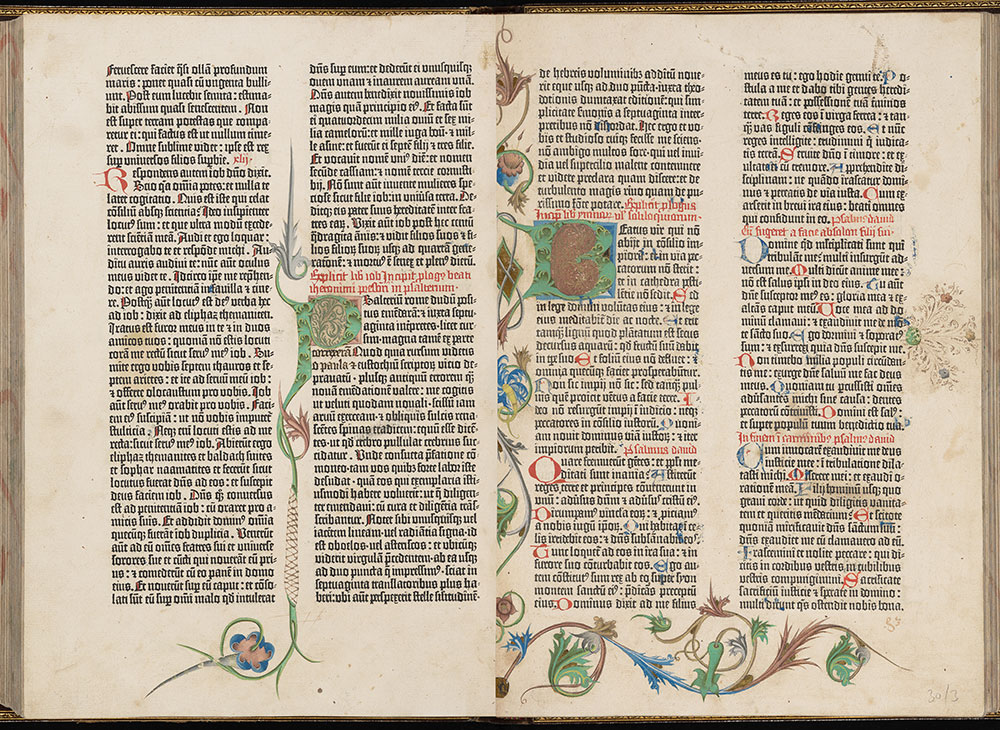
MAINZ: ECCLESIASTICAL CAPITAL AND CRADLE OF PRINTING
The earliest mention of printed books in Europe is a 1455 letter sent to Emperor Frederick III (1415–1493), describing what must have been copies of the Gutenberg Bible for sale at the imperial Diet in Frankfurt. Several years earlier, Johann Gutenberg (ca. 1400–1468) had begun working with his financial backer, Johann Fust (d. 1466), to develop a printing press with moveable type (metal-cast letters), able to produce multiple copies of a text. Their now-famous two-volume Bible was issued in an edition of approximately 180 copies. Imitating the old-fashioned textura script of Gothic manuscripts, Gutenberg attempted to compete with deluxe, handmade commissions. In 1455, a bitter lawsuit ended Fust and Gutenberg’s relationship. The financier continued to run a successful press with Gutenberg’s former assistant, Peter Schoeffer (d. 1503). Later adapted to contain just the Old Testament, this unique copy of Gutenberg’s Bible served as the model for Fust and Schoeffer’s 1462 Bible. Its illumination was added around that time by an artist from Mainz who worked exclusively in Fust’s workshop.
Gutenberg Bible, in Latin
Mainz: Johann Gutenberg & Johann Fust, ca. 1455
The Morgan Library & Museum, PML 12, fols. 292v–293r
Purchased by J. Pierpont Morgan with the Irwin Collection, 1900
Jeffrey Hamburger, Kuno Francke Professor of German Art & Literature, Harvard University
Mainz was the largest and most powerful archbishopric in central Europe. Its archbishop
became not simply one of the ecclesiastical electors, but also archchancellor of the Empire, with the right to convene and lead elections of the king of Germany. Gutenberg, a citizen of Mainz, set up his print shop there no later than 1450 and by 1455 the Gutenberg Bible, the first Western book printed from moveable type, was published in approximately 160 to 180 copies.
Gutenberg’s investment in the production of a large-format folio bible was hardly self-evident. Despite the paramount importance of the text, the market for complete bibles, as opposed
to liturgical books, was limited.
The Morgan Library, exceptionally, holds three copies of the Gutenberg Bible, two of them complete. One of these belongs to the limited number printed on vellum; another belongs to the majority that were printed on rag-linen paper.
The Morgan’s third copy, exhibited here, is unusual on several counts. Unlike most copies of the Gutenberg Bible, which split the text evenly across two volumes at the end of the Psalms, this copy comprises just the Old Testament in a single volume—likely a later modification. Twenty-two of its pages feature a unique set of replacement type settings, which indicate that the copy was produced at the very end of the print run. Finally, it also contains the earliest extant compositor’s marks (typesetters’ indications of pagination) introduced when it was used as a model by Fust and Schoeffer, formerly Gutenberg’s financial backer and apprentice, respectively, to print their own bible in 1462.
In copies of the Gutenberg Bible, most of the decoration had to be added by hand and remains modest compared to sumptuous illuminated manuscripts of the period, which competed with printing by supplying precisely what printers were not in a position to provide—namely, elaborate imagery in brilliant color.
